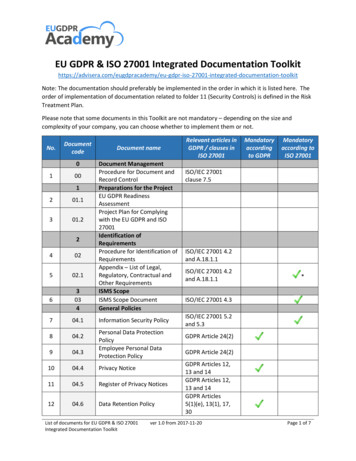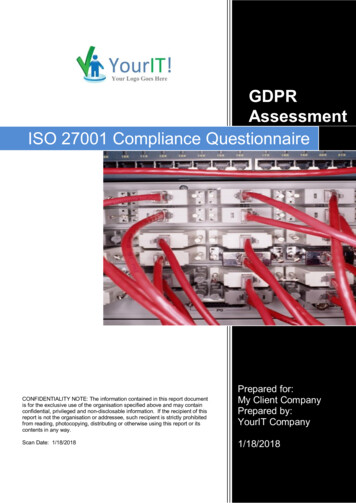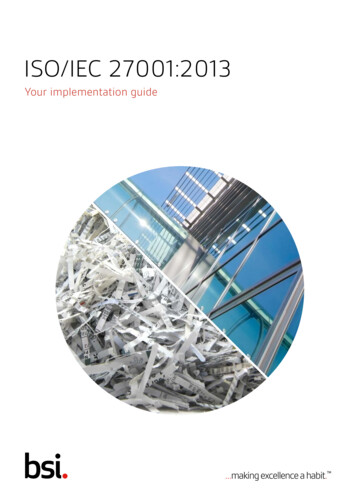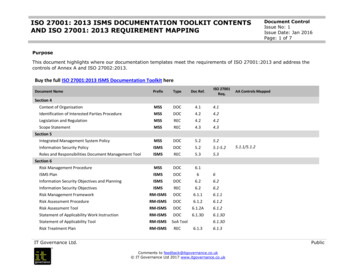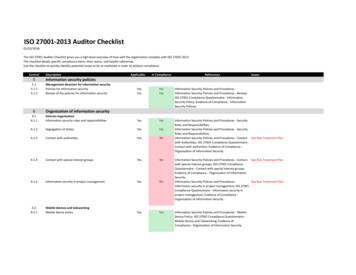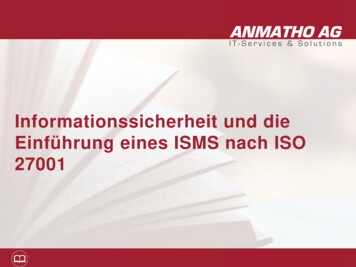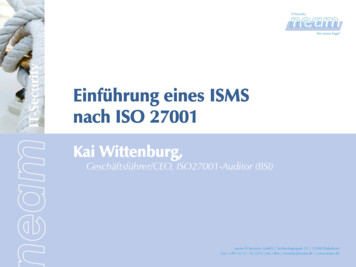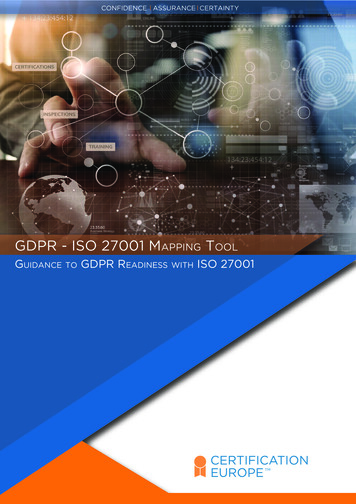
Transcription
CONFIDENCE ASSURANCE CERTAINTYGDPR - ISO 27001 MAPPING TOOLGUIDANCE TO GDPR READINESS WITH ISO 27001
This mapping table does not constitute as legal advice for meeting the European General Data Protection Regulation (EU GDPR) requirements.Upon reviewing the mapping table, please note that the ISO 27001 controls without the prefix ‘A’ are in the main body of ISO/IEC 27001:2013. Those prefixed with ‘A’ are listedin Annex A of ISO/IEC 27001:2013 and are explained in more detail in ISO/IEC 27002:2013 – a supplementary guideline standard on information security controls. Furtherstandards in the ISO 27000 family fill-in various supplementary details (e.g. ISO/IEC 27005 on information risk management and ISO/IEC 27018 on privacy in cloud computing),while other ISO and non-ISO standards and resources provide lots more information, and in some case recommend alternative or complementary approaches and controls.GDPRISO 27001ArticleOutline/summaryControlNotes1GDPR concerns the protection and free movement of “personal data”,defined in article 4 as “any information relating to an identified or identifiablenatural person (‘data subject’); an identifiable natural person is one who canbe identified, directly or indirectly, in particular by reference to an identifiersuch as a name, an identification number, location data, an online identifieror to one or more factors specific to the physical, physiological, genetic,mental, economic, cultural or social identity of that natural person”.A.18.1.4etc.The ISO 27001 standards concern information risks, particularly themanagement of information security controls mitigating unacceptablerisks to organisations’ information. In the context of GDPR, privacy islargely a matter of securing people’s personal information, particularlysensitive computer data. The ISO 27001 standards specifically mentioncompliance obligations relating to the privacy and protection of personalinfo (more formally known as Personally Identifiable Information - PII - insome countries) in control A.18.1.4.2GDPR concerns “the processing of personal data wholly or partly byautomated means .” (essentially, IT systems, apps and networks) and ina business or corporate/organisational context (private home uses are notin scope).ManyISO 27001 concerns information in general, not just computer data,systems, apps and networks. It is a broad framework, built around a‘management system’. ISO 27001 systematically addresses informationrisks and controls throughout the organisation as a whole, including butgoing beyond the privacy and compliance aspects.3GDPR concerns personal data for people in the European Union whether isit processed in the EU or elsewhereA.18.1.4etc.ISO 27001 is global in scope. Any organisation that interacts with peoplein the European Union may fall under GDPR, especially of course if theycollect personal info.4GDPR privacy-related terms are formally defined here.3ISO/IEC 27000 defines most ISO 27001 terms including some privacyterms. Many organisations have their own glossaries in this area. Checkthat any corporate definitions do not conflict with GDPR.Chapter I General provisionsPage 2 of 13
GDPRISO 27001ArticleOutline/summaryControlNotes5Personal data must be: (a) processed lawfully, fairly and transparently; (b)collected for specified, explicit and legitimate purposes only; (c) adequate,relevant and limited; (d) accurate; (e) kept no longer than needed; (f)processed securely to ensure its integrity and 4.1A.10A.13.2A.14.1.1A.15A.17A.18 .in factalmost all!Business processes plus apps, systems and networks must adequatelysecure personal information, requiring a comprehensive suite oftechnological, procedural, physical and other controls starting with anassessment of the associated information risks. See also ‘privacy bydesign’ and ‘privacy by default’ (Article 25).[This is the latest incarnation of the original OECD principles published wayback in 1980 tips hat .]6The “controller” is accountable for all that.5A.6.1.1Although not stated as such, accountability is an important concept withinthe ‘Leadership’ section of ISO/IEC 27001.Lawful processing must: (a) be consented to by the subject for the statedpurpose; (b) be required by a contract; (c) be necessary for othercompliance reasons; (d) be necessary to protect someone’s vital interests;(e) be required for public interest or an official authority; and/or (f) be limitedif the subject is a child.6.1.2A.14.1.1A.18.1.1etc.This should also be covered in the assessment and treatment ofinformation risks.It will influence the design of businessprocesses/activities, apps, systems etc. (e.g. it may be necessary todetermine someone’s age before proceeding to collect and use theirpersonal info). These are business requirements to limit and protectpersonal information: many security controls are required in practice tomitigate unacceptable information risks that cannot be avoided (by notcollecting/using the data) or shared (e.g. relying on some other party toget consent and collect the data - a risk in its own right!).A.8.2.3A.12.1.1A.13.2.4?A.18.1.3There is a requirement to request informed consent for processing(otherwise stop!) and to be able to demonstrate this. Procedures need tobe in place for this and records demonstrating the consent must beprotected and retained.6.1.2A.14.1.1A.8.3.2Withdrawal of consent implies the capability to locate and remove thepersonal info, perhaps during its processing and maybe also fromNote: there are several detailed and explicit requirements concerning lawfulprocessing - see GDPR!Note also that EU member states may impose additional rules.7In order to satisfy these requirements, organisations need to know wherepersonal info is, classify it and apply appropriate measures to address(a)-(f).The data subject’s consent must be informed, freely given and they canwithdraw it easily at any time.Page 3 of 13
GDPRArticleOutline/summaryISO 27001ControlNotesA.13.2etc.backups and archives, plus business processes to check and handlerequests.8Special restrictions apply to consent by/for children.SeeArticle 7These special restrictions apply primarily at the time information isgathered (e.g. getting a parent’s consent).9Special restrictions apply to particularly sensitive data concerning aperson’s race, political opinions, religion, sexuality, genetic info and otherbiometrics etc. Processing of such info is prohibited by default unlessconsent is given and processing is necessary (as defined in the Article).A.8.2.1A.8.2.3A.14.1.1See 7 above. It is important to identify where sensitive data may beprocessed, whether that is ‘necessary’ in fact, and to obtain explicitconsent - factors to be considered in the design of systems, apps andbusiness processes.10Special restrictions also apply to personal data concerning criminalconvictions and Any use of this information should be identified and only processed inspecific circumstances. Such information should preferably not beretained except by the authorities but may be needed for backgroundchecks, credit/fraud risk profiling etc.11Some restrictions don’t apply if a person cannot be identified from the dataheld.A.8.2.1A.8.2.36.1.2A.14.1.1etc.Avoiding information risks (by NOT knowing who the subjects are) is agood option, where feasible: does the business really need to know aperson’s identity or will aggregate info/statistics suffice?Chapter III Rights of the data subject12Communications with data subjects must be transparent, clear and easilyunderstood.A.12.1.1A.14.1.1A.16etc.See above. This affects the wording of web forms, notifications,telephone scripts etc. plus the processes. It may also be relevant toincident management i.e. mechanisms allowing people to enquire orcomplain in relation to their own personal information (implying a meansto identify and authenticate them), for responding promptly, and forkeeping records of such comms (e.g. to limit or charge for excessiverequests)13When personal data are collected, people must be given (or alreadypossess) several specific items of information such as details of the dataA.8.2.1A.8.2.3Procedures for the provision of fair processing information, informationon the data controller and purposes for processing the data need to bePage 4 of 13
GDPRArticleISO 27001Outline/summaryControlNotes“controller” and “data protection officer”, whether their info will be exported(especially outside the EU), how long the info will be held, their rights andhow to enquire/complain etc.A.12.1.1A.14.1.1A.16etc.defined and implemented. This relies in part on identifying wherepersonal info is in use.14Similar notification requirements to Article 13 apply if personal info isobtained indirectly (e.g. a commercial mailing list?): people must beinformed within a month and on the first communication with them.A.8.2.1A.8.2.3A.12.1.1A.14.1A.16etc.See Article 13.15People have the right to find out whether the organisation holds theirpersonal info, what it is being used for, to whom it may be disclosed etc.,and be informed of the right to complain, get it corrected, insist on it beingerased etc.People have rights to obtain a copy of their personal etc.Subject rights include being able to obtain a copy of their own info (againimplying the need for identification and authentication before acting onsuch requests), disclosing the nature of processing e.g. the logic behindand the consequences of ‘profiling’, and info about the controls if theirdata are exported. It may also affect backup and archive copies. See alsoArticle 7 on withdrawal of consent.16People have the right to get their personal info corrected, completed,clarified etc.A.12.1.1A.14.1A.9A.16?A.12.3A.18.1.3Implies functional requirements to check, edit and extend stored info, withvarious controls concerning identification, authentication, access,validation etc. It may also affect backup and archive copies.17People have a right to be forgotten i.e. to have their personal info erasedand no longer used.6.1.2A.14.1.1A.9A.16A.12.3A.8.3.2This is a form of withdrawing consent (see Article 7). Implies system &process functional requirements to be able to erase specific stored info,with various controls concerning identification, authentication, access,validation etc. It may also affect backup and archive copies.18People have a right to restrict processing of their personal info.6.1.2A.8.2.1A.8.2.3A.12.1.1See Articles 7, 12 etc.May need ways to identify the specific data that is to be restricted andimplement new handling / processing rules. Note it may also affectbackup and archive copies.Page 5 of 13
GDPRArticleOutline/summaryISO e have a right to know the outcome of requests to have their personalinfo corrected, completed, erased, restricted g the originator is a conventional part of the incidentmanagement process, but there may be a separate or parallel processspecifically for privacy complaints, requests etc. since the originators hereare not usually employees/insiders.20People have a right to obtain a usable ‘portable’ electronic copy of theirpersonal data to pass to a different epending on your organisation’s purpose, this may seem such anunlikely scenario in practice (low risk) that it may best be handled byexception, manually, without automated IT system functions. Note thatthe extracted data must be limited to the identified and authenticatedperson/s concerned, and must be communicated securely, probablyencrypted. It may also imply erasing or restricting the data and confirmingthis (Articles 17, 18 and 19).21People have a right to object to their information being used for profiling andmarketing purposes.6.1.2A.12.1.1A.14.1.1A.16A.12.3etc.See article 18.May need ways to identify the specific data that is not to be processedand implement new handling / processing rules.22People have a right to insist that key decisions arising from automaticprocessing of their personal info are manually filing and decision support systems involving personal info must allowmanual review and overrides, with the appropriate authorization, accessand integrity controls etc.Page 6 of 13
GDPRISO 27001ArticleOutline/summaryControlNotes23National laws may modify or override various rights and restrictions fornational security and other purposes.A.18.1.1This is primarily of concern to the authorities/public bodies and theirsystems (e.g. police, customs, immigration, armed forces), but may affectsome private/commercial organisations, either routinely (e.g. legal sector,defence industry, ISPs, CSPs, money laundering rules in financialservices?) or by exception (implying a legally-sound manual process toassess and handle such exceptional situations).Chapter IV Controller and processor24The “controller” (generally the organisation that owns and benefits fromprocessing of personal info) is responsible for implementing appropriateprivacy controls (including policies and codes of conduct) considering therisks, rights and other requirements within and perhaps beyond GDPR.4, 5, 6, 7,8, 9, 10and muchof AnnexAThis is a formal reminder that a suitable, comprehensive mesh of privacycontrols must be implemented, including policies and procedures as wellas technical, physical and other controls addressing the information risksand compliance obligations. The scale of this typically requires astructured, systematic approach to privacy. Given the overlaps, itnormally makes sense to integrate or at least align and coordinate privacywith the ISO 27001 ISMS and other aspects such as compliance andbusiness continuity management - in other words, it is a governanceissue.25Taking account of risks, costs and benefits, there should be adequateprotection for personal info by design, and by default.6 andmuch ofAnnex AThere are business reasons for investing appropriately in privacy,including information risks and compliance imperatives, as well asimplementation options with various costs and benefits: elaborating onthese is a good way to secure management support and involvement,plus allocate the funding and resources necessary to design, deliver,implement and maintain the privacy arrangements. Privacy by designand by default are examples of privacy principles underpinning thespecification, design, development, operation and maintenance ofprivacy-related IT systems and processes, including relationships andcontracts with third parties e.g. ISPs and CSPs.Page 7 of 13
GDPRISO 27001ArticleOutline/summaryControlNotes26Where organisations are jointly responsible for determining and fulfillingprivacy requirements collaboratively, they must clarify and fulfil theirrespective roles and ations need to manage relationships with business partners,ensuring that privacy and other information security aspects don’t fallbetween the cracks. This includes, for instance, jointly investigating andresolving privacy incidents, breaches or access requests, achieving andmaintaining an assured level of GDPR compliance, and respectingconsented purposes for which personal info was initially gathered,regardless of where it ends up.27Organisations outside Europe must formally nominate privacyrepresentatives inside Europe if they meet certain conditions (e.g. theyroutinely supply goods and services to, or monitor, Europeans).5.37.5.1A.15?A.18.1.4This is one of many compliance formalities: the Privacy Officer (or DataProtection Officer or equivalent) should be accountable for making surethis is done correctly.28If an organisation uses one or more third parties to process personal info(‘processors’), it must ensure they too are compliant with GDPR.8.29.1A.15A.18.1.1A.18.1.3A.18.1.4This applies to ISPs and CSPs, outsourced data centres etc., plus othercommercial services where the organisation passes personal info to thirdparties e.g. for marketing plus HR, payroll, tax, pension and medicalservices for employees. It also applies on the receiving end: servicesuppliers can expect to be questioned about their GDPR compliancestatus, privacy policies and other controls (e.g. any subcontractors), andto have compliance and assurance clauses/terms and liabilities includedin contracts and agreements. The information risks need to be identified,assessed and treated in the normal manner, on both sides.29Processors must only process personal info in accordance with instructionsfrom the controller and applicable laws.MostProcessors need to secure and control personal info in much the sameway as controllers. They may well be controllers for personal info onemployees etc. so will hopefully have all necessary privacy arrangementsin hand anyway: it’s ‘just’ a case of extending them to cover client info,and manage privacy within client relationships (e.g. how to handlebreaches or other enquiries, incidents and issues).30Controllers must maintain documentation concerning privacy e.g. thepurposes for which personal info is gathered and processed, ‘categories’ ofdata subjects and personal data etc.7.531Organisations must cooperate with the authorities e.g. privacy or dataprotection ombudsmen.A.6.1.3More important formalities.Another formality.Page 8 of 13
GDPRISO ions must implement, operate and maintain appropriate technicaland organisational security measures for personal info, addressing theinformation risks.8.28.3and mostof AnnexAGDPR mentions a few control examples (such as encryption,anonymization and resilience) covering data confidentiality, integrity andavailability aspects, plus testing/assurance measures and compliance byworkers (implying policies and procedures, awareness/training andcompliance enforcement/reinforcement). An ISO 27001 ISMS providesa coherent, comprehensive and structured framework to manage privacyalongside other information risk and security controls, compliance etc.33Privacy breaches that have exposed or harmed personal info must benotified to the authorities promptly (within 3 days of becoming aware of themunless delays are justified).A.16A.18.1.4Breaches etc. would normally be handled as incidents within the ISMSincident management process but GDPR-specific obligations (such asthe 3-day deadline for notifying the authorities) must be fulfilled. Notethat losses or thefts of IT devices containing personal info are probablynot notifiable if the data are strongly encrypted (but remember this is NOTlegal advice!). Note also that the point the clock starts ticking is notexplicitly defined: it is arguably appropriate to gather and assess theavailable information/evident first to determine whether or not areportable incident has actually occurred i.e. the clock may not start untilthe incident is declared genuine, not a false-alarm.34Privacy breaches that have exposed or harmed personal info and hence arelikely to harm their interests must be notified to the people so affected‘without undue delay’.A.16A.18.1.4Aside from the legal and ethical considerations and direction/guidancefrom the privacy authorities, there are obviously significant businessissues here concerning the timing and nature of disclosure. This wouldnormally be a part of the incident management process for serious orsignificant incidents, involving senior management as well as specialistsand advisors. Avoiding exactly this situation and the associated businesscosts, disruption and aggravation is one of the strongest arguments tomake privacy a corporate imperative, and to invest appropriately inappropriate preventive measures. The same point applies to otherserious/significant information incidents of course.35Privacy risks including potential impacts must be assessed, particularlywhere new technologies/systems/arrangements are being considered, orotherwise where risks may be significant (e.g. ‘profiling’ defined in Article 4as “any form of automated processing of personal data consisting of the useof personal data to evaluate certain personal aspects relating to a naturalperson, in particular to analyse or predict aspects concerning that naturalperson's performance at work, economic situation, health, personal6.1.2A.6.1.3A.8.2.1ISO/IEC27005and ISO31000Again, there are sound business and ethical reasons to identify, assessand treat information risks (including privacy and compliance risks), asidefrom the GDPR obligations. Privacy-related risks should probably beincluded in corporate risk registers alongside various other risks. GDPRalso hints at integrating the assessment of privacy risks as part of theroutine risk assessment activities for business change projects, new ITsystems developments etc.Page 9 of 13
GDPRArticleOutline/summaryISO 27001ControlNotespreferences, interests, reliability, behaviour, location or movements”).‘Significantly risky situations’ are to be defined by the national privacyauthorities, apparently.36Privacy risks assessed as “high” [undefined] should be notified to theauthorities, giving them the chance to comment.6.1.2A.6.1.3A.8.2.1ISO/IEC27005and ISO31000The GDPR requirement is well-meaning but vague: this might be coveredin corporate policies concerning the precise definition of “high” privacyrisks but on the other hand explicit inputs from the authorities may behelpful in terms of an official position on the suitability and adequacy ofproposed controls - in other words this comes down to a businessrisk/strategic decision by management.37A data protection officer must be formally identified under specifiedcircumstances e.g. public bodies, organisations regularly and systematicallymonitoring people on a large scale, or those performing large-scaleprocessing of sensitive personal info relating to criminal records.5.3A.6.1.1A.18.1.4Aside from GDPR obligation, the “Privacy Officer” role (or equivalenttitles) is much more broadly applicable and valuable, whether full or parttime, formal or informal, notifiable or not. There are clearly many anglesto privacy: a designated corporate focal point for privacy (ideally acompetent privacy specialist or expert) makes sense for virtually allorganisations. This is another governance issue.38[If formally designated] the data protection officer must be supported by theorganisation and engaged in privacy matters.5.3A.6.1.1A.18.1.4See above. Formalities aside, without management support andengagement with the organisation, a Privacy Officer is powerless andpointless.39[If formally designated] the data protection officer must offer advice onprivacy matters, monitor compliance, liaise with the authorities, act as acontact point, address privacy risks etc.5.3A.6.1.1A.18.1.4See above. The GDPR requirements would form the basis of a PrivacyOfficer role description.40Various authorities, associations and industry bodies are anticipated todraw up codes of conduct elaborating on GDPR and privacy, offer them tobe formally approved (by an unspecified mechanism) and (whereappropriate) to implement their own (member) compliance mechanisms.5.3,A.6.1.1A.18.1.4Although this is a valiant attempt to add weight to industry codes, itstruggles to achieve a full legal mandate but the ethical obligation isclear: privacy is more than just a matter of strict compliance with formal,legal obligations. Aside from that, codes (and ISO 27001 standards!)offer good practice guidance, and compliance may generatecommercial/marketing advantages.41The bodies behind codes of conduct are required to monitor compliance (bytheir members), independently and without prejudice to the legal andregulatory compliance monitoring conducted by the national authorities.5.3A.6.1.1A.18.1.4See above.Page 10 of 13
GDPRISO 27001ArticleOutline/summaryControlNotes42Voluntary data protection certification schemes offering compliance sealsand marks (valid for 3 years) are to be developed and registered.5.3A.6.1.1A.18.1.4Similar schemes already exist: GDPR gives them some officialrecognition, on top of the commercial advantages they already exploit.43Certification bodies that award compliance seals and marks should becompetent and accredited for this purpose. The European Commissionmay impose technical standards for certification schemes.5.3A.6.1.1A.18.1.4This should improve the credibility and meaning of privacy seals andmarks, but may also increase the costs. Since they are voluntary,whether or not to be certified, and which schemes to join, arecommercial/business matters for management.Chapter V Transfers of personal data to third countries or international organisations44International transfers and processing of personal info must fulfilrequirements laid down in subsequent Articles.-45Data transfers to countries whose privacy arrangements (laws, regulations,official compliance mechanisms .) are deemed adequate by the EuropeanCommission (i.e. compliant with GDPR) do not require official authorisationor specific additional safeguards.A.18.1.4Most formalities are to be handled by the Commission. Complianceinvolves avoiding transfers to other countries, monitoring the official listsfor changes, and ensuring that suitable contracts/agreements and otherprivacy controls are in place as with other third party data transfers (seeArticle 28 especially).46Data transfers to countries whose privacy arrangements (laws, regulations,official compliance mechanisms .) are not deemed adequate by theEuropean Commission (i.e. compliant with GDPR) but meet certain othercriteria require additional safeguards.A.18.1.4Essentially, the organisation must implement and ensure the adequacyof privacy controls before transferring personal data to such countries,and subsequently e.g. suitable contractual clauses and complianceactivities.47National authorities may approve legally-binding privacy rules permittingtransfers to non-approved countries.A.18.1.4Formalities may affect contractual terms, compliance arrangements,liabilities etc. Hint: it may not be worth the aggravation, risks and costs.48Requirements on European organisations from authorities outside Europeto disclose personal data may be invalid unless covered by internationalagreements or treaties.A.18.1.4,A.16Such situations would normally be handled by legal and regulatorycompliance specialists - but may start out as incidents.49Yet more conditions apply to personal info transfers to non-approvedcountries e.g. explicit consent by the data subjects.A.18.1.4The Commission is deliberately making it difficult, or rather taking greatcare since the privacy risks are higher.50International authorities will cooperate on privacy-Preamble.-Page 11 of 13
GDPRArticleOutline/summaryISO 27001ControlNotesChapter VI Independent supervisory authorities51-59 [Concern national bodies to oversee privacy.]------Chapter VII Cooperation and consistency60-76 [Concern supervisory authorities and the EU Data Protection Board.]Chapter VIII Remedies, liability and penalties77-81 [Supervisory authorities can deal with privacy complaints.]82Anyone damaged by infringements of GDPR has a right to compensationfrom the controller/s or processor/s.A.18.1.4-83Administrative fines imposed by supervisory authorities shall be “effective,proportionate and dissuasive”. Various criteria are defined. Depending onthe infringements and circumstances, fines may reach 20 million Eurosor up to 4% of total worldwide annual turnover for the previous year ifgreater.6A.18.1.4Such huge fines are clearly intended to be a strong deterrent,representing a significant part of the potential impact of privacy breachesetc. in the organisation’s assessment of GDPR compliance and otherprivacy risks.84Other penalties may be imposed. They too must be “effective, proportionateand dissuasive”.6A.18.1.4See above.Chapter IX Provisions relating to specific processing situations85Countries must balance privacy/data protection rights against freedom ofexpression, journalism, academic research etc. through suitable laws.6A.18.1.1A.18.1.4Issues under this Article may come down to differing legal interpretationsin court, hence again there are information risks to be identified, assessedand treated where personal information is involved.86Personal data in official documents may be disclosed if the documents areformally required to be disclosed under ‘freedom of information’-type laws.6A.18.1.1A.18.1.4It may be feasible to redact personal or other sensitive information instead- see ISO/IEC 27038.87Countries may impose further privacy controls for national ID numbers.6A.18.1.1A.18.1.4National ID numbers may be used as secret personal authenticators, inwhich case they must remain confidential to reduce the risk of identitytheft. In effect they are sensitive personal information, implying the needPage 12 of 13
GDPRArticleOutline/summaryISO 27001ControlNotesfor encryption and other security/privacy controls.88Countries may impose further constraints on corporate processing and useof personal information about employees e.g. to safeguard human dignityand fundamental rights.6A.18.1.1A.18.1.4Employment laws may intersect with GDPR and privacy, furthercomplicating compliance and altering the information risks in this area.89Where personal data are to be archived e.g. for research and statisticalpurposes, the privacy risks should be addressed through suitable controlssuch as pseudonymization and data minimization where feasible.6A.18.1.4Privacy concerns remain as long as the data subjects are alive (perhapslonger if their families or communities may be impacted by breaches).Taking account of this, the information risks should be identified,assessed and treated appropriately in the normal way.90Countries may enact additional laws concerning workers’ secrecy andprivacy obligations.6A.18.
Upon reviewing the mapping table, please note that the ISO 27001 controls without the prefix ‘A’ are in the main body of ISO/IEC 27001:2013. Those prefixed with ‘A’ are listed in Annex A of ISO/IEC 27001:2013 and are explained in more detail in ISO/IEC 27002:2013 – a supplemen
